As a rabbit enthusiast, I spend a lot of time discussing my rabbits with friends and new bunny owners and they are often surprised when I tell them I give a couple of my own a completely free run of the house. Concerned about poop they quite often ask me ‘can you litter train a rabbit?’ here’s what I tell them….
Litter training a rabbit is not only possible but it is amazingly simple, however, a young or baby rabbit should not be given the freedom to roam a house until it has been neutered or spayed and trained to use a litter box, otherwise you will find poop all over your house.
Seasoned rabbit owners know all too well how much rabbits poop! Rabbits are quite literally pooping machines, in fact, the average rabbit can produce up to around 200 droppings a day, not surprising at all when you consider that on that very same day they might also eat a ball of hay equal to the size of themselves!
As a new rabbit owner the amount of poop can be a shock, they seem to just fall out of your rabbit at every opportunity! Fortunately, a buns vegetarian and high fiber diet ensures for the most part its droppings arrive as compact pellets which are neither smelly nor unpleasant.
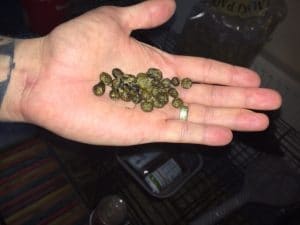
That said teaching your rabbit to use a litter box or tray is still a positive action, it makes for a more house-friendly pet, keeps your husband or wife on side and your bun’s extremely good manners will surely impress any house guests!
Considerations Before Litter Training
Rabbits all have different personalities and attention spans so training some to use a litter box may be more difficult than others. Having myself trained several rabbits to successfully use a litter tray/box over the years I have recognized the factors that seem to affect the speed at which they learn this behavior.
I have known rabbits that have literally required no training whatsoever, while others have taken real persistence with the steps described in this article.
One such factor which seems to affect your rabbit’s willingness to use a litter tray is age. Much like children, baby rabbits have shorter attention spans and prove considerably more difficult to train
In contrast, as soon as a rabbit reaches maturity (and recovered from spaying or neutering procedures) their pooping habits become more controlled and they are much more willing to learn (or at least much more open to being bribed into certain actions using tasty treats!)
While every rabbit is different the most important thing to remember when trying to teach your rabbit anything new is to always keep him happy and healthy.
Your rabbit will be quicker to respond to training if you as an owner always treat him with kindness.
So follow the simple steps in one of the following methods along with some patience and you’ll have your rabbit fully litter box trained in no time at all!
Step 1 – Gathering Supplies
There are a few things that you will need before starting to train your rabbit. Some of these supplies you may be able to gather for free or next to nothing while some will cost considerably more.
Cages/Hutches/Puppy Pens
When first purchasing a rabbit the first thing that most of us buy is a cage or hutch so unless you are yet to buy your rabbit we’re assuming that you already have this.
That said if your cage is not big enough to accommodate a litter tray while also allowing necessary space for the rabbit to stretch out and move around you may wish to consider something larger that can facilitate training better.
Puppy pens are ideal as the open-top design of them takes away the restriction of movement your rabbit feels within a hutch or cage (although naughtier bunnies may attempt an escape!)
While cruel and detrimental to your relationship with your rabbit to limit him to a small living area long-term, short-term ‘confinement’ will make training much easier.
Also note that although we talk about confining the rabbit to limited space in this article, we do not mean treating him like a battery hen!
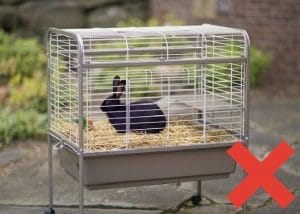
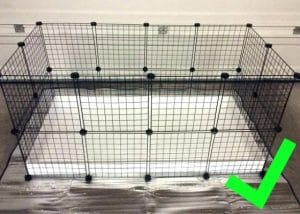
Trays and Scoops
Once you have an adequate sized cage you will need to also purchase a litter tray and scoop. For trays, although those designed specifically for rabbits exist, you will find that cat litter trays are more readily available and are fine for this purpose.
Your rabbit will easily jump in and out of these trays as the height of the sides are not excessively high.
When choosing a tray also consider that a rabbit will often lie down or stretch out in it so aim to get one that has adequate width and length too.
Note. If your intention is to have a free roam house bunny you may wish to buy a couple of trays or more that can be strategically placed around the house (for the convenience of the rabbit)
Disinfectant
You will regularly be changing your rabbit’s litter tray and of course, the smell will get stronger the more your rabbit poops and pees in it.
While we recommend retaining some of the rabbit’s scent within the tray with simple ‘rinse’ cleaning 2-3 times a week, you will also need to use a good brand of rabbit-safe disinfectant every couple of weeks to prevent the build-up of harmful bacteria.

Newspaper
Collecting newspapers is always a good idea when keeping rabbits, not only for lining the bottom of litter trays to make them easier to clean out but also for cage/hutch bottoms where they will soak up damp from any bunny accidents.
This can make cleaning out a much simpler task (providing your rabbit does not choose to shred it into a million pieces!). Free newspapers can be obtained depending on which city you live, failing that asking friends and family to keep newspapers for you is also good practice.
Litter
Litter is in our opinion an optional requirement as we have also had equal success using just hay. As your rabbit will eat where he poops and pees, adding a layer of litter just means adding something else that may be ingested by the rabbit.
That said using litter will certainly soak up some of the rabbit urine and will also prevent smell building up to the point where it can be smelt throughout your property if you happen to forget to clean it out for a day.
If you do wish to use litter choosing the right brand is essential and your rabbit’s safety should always be your number one consideration.
Unsuitable litters have been known to cause blockages and even death to rabbits through ingestion.
Never trust litters just because they have been labeled as rabbit safe as just like commercially available rabbit treats, they often contain ingredients that may harm your pet.
Pay careful attention to wooden chip-style litters available and ensure they have not been treated with chemicals or oils that may irritate your rabbit’s delicate eyes (or worse still get into his lungs). Finally, never use cat-type, clay-based litters that clump when wet as these will cause serious medical issues if ingested.
Our own recommendation is to cut out the uncertainty by using simple paper/cardboard-based litters or hay.

Read our full guide to suitable litter for rabbits here.
Step 2 – Neuter or Spay the Rabbit
(Skip to step 4. If you already have a neutered or spayed rabbit!)
As mentioned previously it is much easier to train an older spayed/neutered rabbit to start using a litter tray rather than a boisterous baby rabbit who just wants to jump and play.
After building your rabbit’s confidence around you following Step 1. The rabbit will need to be neutered or spayed.
This can be carried out between 4-6 months (dependant on the sex of the rabbit, 4 months for males/6 months for females).
After a neutering or spaying procedure, a period of recovery of a couple of weeks or more will be necessary.
During this delicate time allow the rabbit peace and quiet, make sure he’s well hydrated, and line the bottom of the cage using newspaper to avoid aggravating the injury until it has a chance to heal.
When your rabbit seems to be getting back to its old self again you can begin the practical part of the training.
Step 3 – Be Patient
This step while an important part of your rabbit’s training actually requires minimal effort on your part!
Simply provide the rabbit a litter tray that appeals to him, and the chance to grasp the basics of using a litter tray himself.

Also remember that before any training starts on a rabbit, it is important to get him used to being in your company.
If you’re keeping his temporary living space in a separate room make sure you have plenty of contact, even just sitting on the floor next to his cage/pen and talking to him will help.
Providing plenty of enrichment through toys, grooming and handling will also help you to build a good bond with your rabbit.
Step 4 – Training Process
Eventually having a very large living space and giving your rabbit as much freedom as possible is crucial but as previously mentioned for this training to be successful you will first be limiting the space available to him.
While obviously not as exciting as having the run of your entire house, a large indoor cage (or preferably a puppy pen) will allow your rabbit enough space to stretch out or stand upright while also forcing him to get used to pooping in one area.
A rabbit will usually go to the bathroom in one particular corner of his living space so before you place the tray inside, pay careful attention to the spot where your rabbit likes to go toilet.
Once this is established, place the tray at this location and food and water provisions on the opposite side.
Your rabbit will also like to eat where he pees so entice him into using the tray by putting down a layer of newspaper followed by a few delicious handfuls of his favorite timothy hay. This will further persuade him into using the tray.
Observe your bun’s behavior within his living space and as soon as you see him poop outside his tray, scoop up those pellets and put them back inside.
You can also do this before putting the tray inside the area so that he is able to get familiar with where you want him to be ‘going’.
Keep him confined within this space until you are sure that he is using the litter tray to do his business.
Every rabbit is different and while my own rabbits got used to using the tray within a day or two, be patient as some rabbits, especially younger ones can take a little longer.
Don’t be disheartened if you find that there seem to be some loose pellets around your rabbit’s tray or cage, rabbits do this in order to mark a territory as their own.
When you are confident that your rabbit is using the tray for the majority of his toilet habits you can start increasing his freedom.
This might be slightly increasing the size of his puppy pen, or opening his cage to allow him to come out into the room.
If you are letting him have the run of a room, only allow your rabbit out for short periods at first. Depending on the amount of space you allow, you may also consider putting numerous litter trays around your home.
This allows your rabbit the choice of where he would like to use the toilet, reducing the distance he needs to go between trays and of course the risk of accidents.
Again fill these litter trays with his favorite tasty timothy hay, and a ‘handful’ of his droppings so that he knows that the tray belongs to him (we know it sounds unappetizing but we can assure you eating where you poop is perfectly natural to your rabbit!)
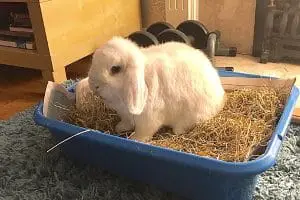
It’s very difficult to know when your rabbit is pooping so you’re bound to encounter a few accidents. When these occur scoop up the droppings (pick them up if you’re not squeamish!) and place them back into one of the litter trays.
Clean accident areas with diluted white vinegar which will dissolve the ammonia in the urine, eradicate scent, and ensure that your rabbit does not consider this location a regular pooping spot.
If your rabbit continues to pee and poop outside of his tray when you are allowing him the freedom to roam consider limiting his space once again until the correct behavior becomes more ingrained.
Clean litter trays out every couple of days by rinsing them with warm water to avoid them becoming too smelly.
Add newspaper and your preferred litter or hay back to the tray before adding a few of the rabbit’s droppings back in to act as a scent marker so your rabbit knows where he is supposed to go.
Clean trays out with disinfectant every couple of weeks and rinse thoroughly, avoid doing this too often as the smell may put your rabbit off using it.
For a while, you will notice the odd dropping around your place (as we said they seem to just fall out of your rabbit) however this should become more infrequent as time goes on. In our experience, a rabbit generally grasps this behavior within a couple of weeks.
Finally whenever you see your rabbit using his litter tray, congratulate him with the odd healthy treat, your rabbit will start to associate his use of the litter tray with the tasty treat and will likely continue his good behavior.
Other Considerations
If your rabbit just doesn’t seem to want to use his tray, it might mean that something in the vicinity of the tray could be bothering him. This may be noise, draughts from doors or windows, even smells from other animals. If you have this issue try moving the tray to somewhere the rabbit seems to feel more comfortable.
Pay attention to your rabbit, if he starts to forget his training or urinating outside of his trays this could indicate unhappiness, stress, or even illness. Treat your rabbit with kindness and monitor him for a few days, if he doesn’t improve consider booking him in for a check-up at a rabbit savvy vet.
Remember your rabbit needs a space of his own where he can be sure that he won’t be hassled. Rabbits learn mostly by association so when allowing him out of the cage don’t reach in to get him, instead allow him the freedom to come and go as he pleases.
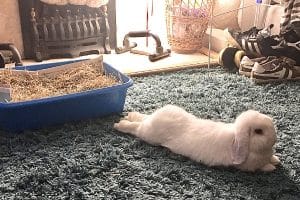
When cleaning his cage always wait until he is not inside. Your rabbit will likely object if you start messing around with his home while he is in there, however, he is also intelligent enough to appreciate a nice clean cage with handfuls of fresh timothy hay when he gets home!
Keep a spray bottle filled with diluted white vinegar, clean up accidents immediately otherwise you may find that your rabbit starts using your new carpet as his permanent litter tray!
Wrap Up
Finally and most importantly, give your rabbits time and NEVER show annoyance or aggression to your rabbit if he has an accident before or after his training, remember they are sensitive and delicate animals that are easily frightened and they hold a grudge!
